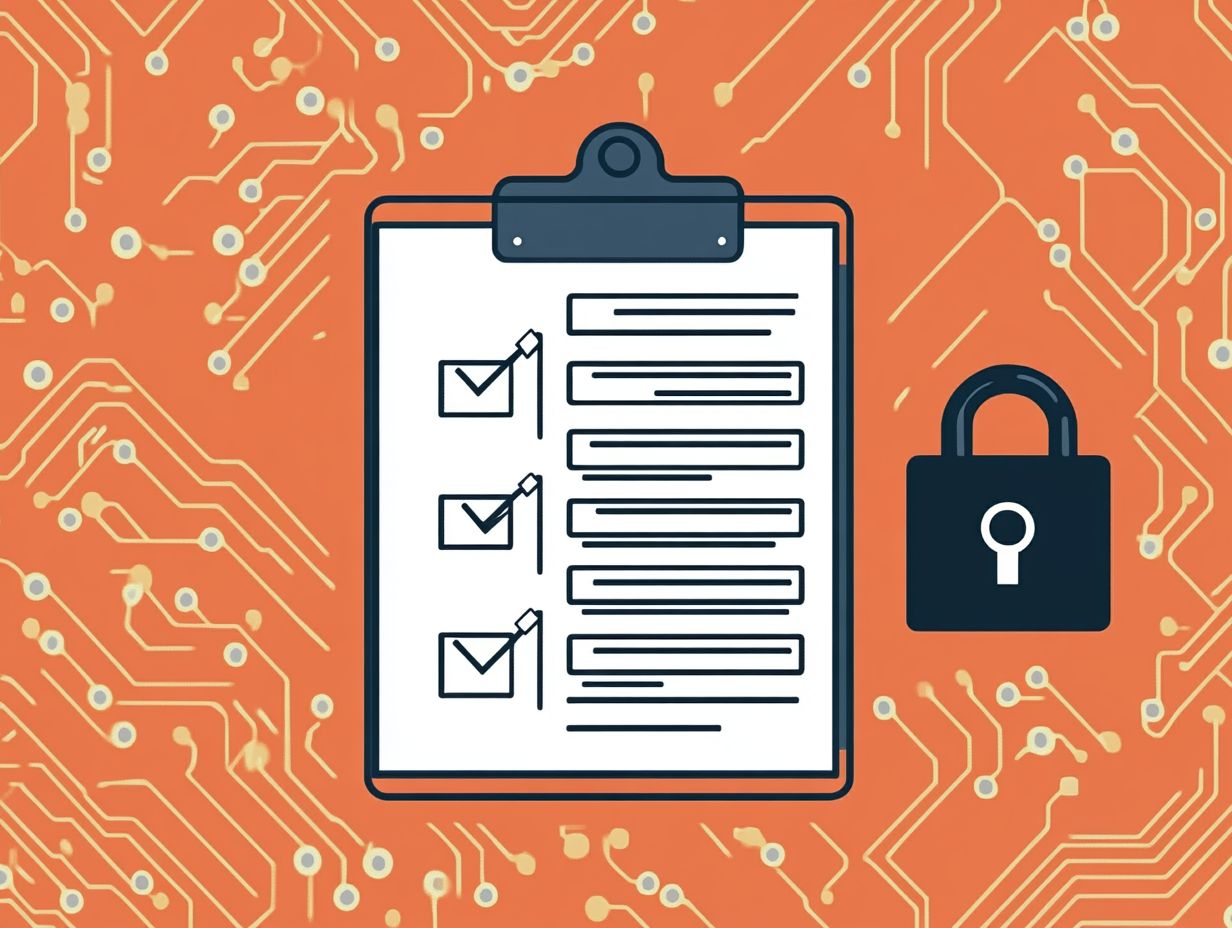what should be included in a cybersecurity policy?
In today’s digital world, protecting sensitive information is vital!
This article covers the key parts of a strong cybersecurity policy. It includes identifying risks, setting up security protocols, and training your team.
It also outlines the steps needed to create and maintain this vital policy, as well as the possible consequences of overlooking these important safeguards. Understanding how a strong cybersecurity policy can enhance your organization against evolving threats is essential for your success.
Contents
- Key Takeaways:
- Understanding Cybersecurity Policies
- Key Elements of a Cybersecurity Policy
- Establishing Security Protocols
- Employee Training and Awareness
- Creating a Cybersecurity Policy
- Implementing and Maintaining the Policy
- Consequences of Not Having a Cybersecurity Policy
- Frequently Asked Questions
- What should be included in a cybersecurity policy?
- Why is it important to have a cybersecurity policy?
- What are some key components that should be included in a cybersecurity policy?
- How often should a cybersecurity policy be updated?
- Who should have access to the cybersecurity policy?
- What are the consequences of not having a cybersecurity policy?
Key Takeaways:

- A cybersecurity policy is crucial for protecting an organization’s sensitive information and preventing cyber attacks.
- The key elements include risk assessment, security protocols, and employee training.
- Regularly updating your cybersecurity policy is necessary for effective implementation and maintenance of security measures.
Understanding Cybersecurity Policies
Knowing about cybersecurity policies is crucial for any organization. A strong policy helps protect sensitive data and IT resources.
A well-crafted cybersecurity policy outlines the necessary guidelines and compliance standards. It also enhances security awareness training among employees.
By addressing risks from people within the organization and defining employee responsibilities, organizations can ensure ongoing training and a solid incident response plan.
Incorporating an access control policy and a remote access policy into the security management framework helps shield IT assets against the evolving landscape of cybersecurity threats.
Definition and Importance
A cybersecurity policy is your organization s formal set of guidelines aimed at protecting sensitive data and IT assets from threats, including insider risks and data breaches.
This policy serves as a roadmap for everyone in your organization, clearly outlining each employee’s roles and responsibilities in maintaining security measures.
It reduces risks and fosters a culture of awareness, emphasizing secure practices.
Moreover, it highlights the need for effective incident response plans, ensuring that your team knows how to react quickly and efficiently during a security breach.
Implementing a well-defined policy strengthens your organization’s defenses, ultimately protecting its reputation and financial stability.
Key Elements of a Cybersecurity Policy

The key elements of a robust cybersecurity policy include identifying and assessing potential risks, defining employee responsibilities, and establishing clear protocols for data breach responses and incident management plans.
Identifying and Assessing Risks
Identifying and assessing risks is a crucial step in crafting a comprehensive cybersecurity policy. It allows you to understand potential threats and implement effective measures.
This process reveals vulnerabilities and prioritizes them based on their potential impact, ensuring that your critical assets receive the attention they need.
Embracing risk assessment helps you design proactive data breach response strategies. This informed approach enables you to develop policies that adapt to the ever-evolving threat landscape.
Effective risk assessment provides actionable insights that can guide your investments in cybersecurity technologies and training, boosting the overall effectiveness of your policies and enhancing resilience against potential breaches.
Establishing Security Protocols
Establecer protocolos de seguridad es esencial para garantizar que la pol tica de ciberseguridad de su organizaci n no sea solo un documento, sino una estrategia efectiva y ejecutable.
Esto incluye desarrollar pol ticas de control de acceso y acceso remoto, que forman la columna vertebral de un marco de seguridad s lido. Estas pol ticas protegen datos sensibles y mantienen la integridad del sistema.
Las pol ticas de control de acceso determinan qui n puede ver o interactuar con recursos espec ficos. Esto le permite mitigar los riesgos asociados con el acceso no autorizado.
A medida que el trabajo remoto se vuelve cada vez m s com n, tener pol ticas de acceso remoto s lidas es crucial. Estas pol ticas describen m todos seguros para que los empleados se conecten a la red de su organizaci n sin comprometer la seguridad.
Para mantenerse un paso adelante de las amenazas cibern ticas en evoluci n, debe priorizar la capacitaci n continua. Empoderar a su personal para reconocer y responder de manera efectiva a posibles debilidades fomenta una cultura de conciencia de seguridad dentro de su organizaci n.
Este enfoque proactivo es clave para proteger sus activos digitales.
Employee Training and Awareness

La capacitaci n y concienciaci n de los empleados son cruciales para una pol tica de ciberseguridad efectiva. Estas pr cticas influyen directamente en el entendimiento de responsabilidades y la adherencia a las pautas de ciberseguridad.
Al implementar programas de capacitaci n en concienciaci n de seguridad, puede fomentar una cultura proactiva que permita a su equipo identificar amenazas potenciales y responder de manera efectiva.
La educaci n continua es fundamental; mantiene a usted y a sus colegas alerta ante las amenazas cibern ticas en constante evoluci n. Esto reduce significativamente los riesgos asociados con errores humanos y debilidades internas.
Este entrenamiento constante cultiva un entorno donde la ciberseguridad se convierte en una responsabilidad compartida. Motiva a todos a mantenerse informados sobre las mejores pr cticas y soluciones emergentes.
Refrescar sus conocimientos regularmente no solo mejora sus capacidades individuales, sino que tambi n refuerza la resiliencia general de la organizaci n contra brechas, protegiendo informaci n sensible y manteniendo la confianza.
Creating a Cybersecurity Policy
Crear una pol tica de ciberseguridad requiere navegar por varios pasos y consideraciones esenciales. Esto asegura que el documento no solo sea completo y ejecutable, sino tambi n ajustado a las necesidades espec ficas de su organizaci n.
Es crucial alinear esta pol tica con pautas de ciberseguridad establecidas e integrarla sin problemas con su plan de continuidad empresarial.
Steps and Considerations
El camino hacia la creaci n de una pol tica de ciberseguridad robusta comienza con una evaluaci n de riesgos completa. Este primer paso vital le permite identificar vulnerabilidades y amenazas potenciales que podr an poner en peligro sus operaciones.
Una vez que haya identificado estos riesgos, es crucial involucrar a las partes interesadas clave, incluidos sus equipos de TI, asesores legales y la alta direcci n. Reunir sus opiniones no solo enriquece la pol tica, sino que tambi n fomenta un esp ritu de colaboraci n.
Despu s de incorporar esta informaci n, debe revisar regulaciones espec ficas de la industria, como HIPAA para la atenci n m dica o GDPR para la privacidad de datos, para asegurarse de que su pol tica cumpla con los est ndares de cumplimiento necesarios.
A continuaci n, querr establecer pautas y procedimientos claros para la respuesta a incidentes, la capacitaci n del personal y las actualizaciones regulares. Este enfoque proactivo le ayudar a adaptarse a amenazas y avances tecnol gicos en evoluci n, asegurando que su organizaci n permanezca resiliente ante los desaf os cibern ticos.
Implementing and Maintaining the Policy

Implementar y mantener una pol tica de ciberseguridad robusta no es una tarea nica; es un compromiso continuo.
Necesita participar en monitoreos y actualizaciones regulares, asegurando que su pol tica se adapte al paisaje siempre cambiante de amenazas y est ndares de cumplimiento en ciberseguridad.
Mant ngase a la vanguardia al adaptar su pol tica r pidamente a nuevas amenazas!
Monitoring and Updating the Policy
Monitoring and updating your cybersecurity policy is crucial for keeping it relevant and effective in tackling new security threats while aligning with your incident response plans.
You can employ various methods to evaluate the success of your cybersecurity strategies, such as conducting regular audits, testing the system’s defenses, and assessing employee training.
By implementing a regular feedback process and analyzing incident reports, you ll be able to pinpoint areas that need improvement and address any gaps in your defenses.
Being proactive strengthens your organization against new threats and keeps you compliant with regulations. Act now to protect your assets!
Consequences of Not Having a Cybersecurity Policy
The absence of a cybersecurity policy can expose you to potential risks that threaten sensitive data, your organization s reputation and overall financial stability.
Data breaches and other cybersecurity incidents can swiftly turn into costly challenges, underscoring the necessity of a robust cybersecurity framework.
Potential Risks and Damages
Lacking a robust cybersecurity policy opens the door to risks and damages, such as heightened vulnerability to insider threats, significant financial losses, and severe compliance breaches.
Without clear guidelines and protocols, your organization may be susceptible to data breaches that could expose sensitive information, ultimately tarnishing your reputation and eroding client trust.
Consider this: a 2020 report revealed that the average cost of a data breach exceeded $3.8 million. This figure reflects not only financial repercussions but also the potential for legal penalties.
A survey showed that approximately 27% of organizations have experienced a breach due to inadequate security measures. These troubling statistics emphasize the critical need for a well-structured cybersecurity policy to mitigate risks and safeguard valuable assets.
Frequently Asked Questions
Have questions about cybersecurity policies? Here are the answers to some common inquiries.
What should be included in a cybersecurity policy?
A cybersecurity policy should include a comprehensive set of guidelines and procedures aimed at protecting an organization’s electronic assets from cyber threats.
Why is it important to have a cybersecurity policy?
A cybersecurity policy is crucial for organizations to establish a proactive approach towards protecting their sensitive data and information from potential cyber attacks.
What are some key components that should be included in a cybersecurity policy?
A cybersecurity policy should outline the roles and responsibilities of employees, procedures for handling security incidents, measures for secure network access, and regular security training and updates.
How often should a cybersecurity policy be updated?
A cybersecurity policy should be reviewed and updated at least once a year or whenever there are significant changes to the organization’s technology infrastructure or security landscape.
Who should have access to the cybersecurity policy?
All employees, including top-level management, should have access to the cybersecurity policy to ensure everyone is aware of their roles and responsibilities in protecting the organization’s data and information.
What are the consequences of not having a cybersecurity policy?
Without a cybersecurity policy, organizations are at a higher risk of experiencing cyber attacks, data breaches, and financial losses. It also makes it difficult for employees to know the appropriate security measures to take, leading to potential vulnerabilities.
Don t wait any longer. Update your cybersecurity policy today to protect your organization!






